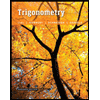The parametric equations x=t+2 and y=+²+ 3t represent a plane curve. Which of the following rectangular equations represents the plane t curve?
The parametric equations x=t+2 and y=+²+ 3t represent a plane curve. Which of the following rectangular equations represents the plane t curve?
Trigonometry (11th Edition)
11th Edition
ISBN:9780134217437
Author:Margaret L. Lial, John Hornsby, David I. Schneider, Callie Daniels
Publisher:Margaret L. Lial, John Hornsby, David I. Schneider, Callie Daniels
Chapter1: Trigonometric Functions
Section: Chapter Questions
Problem 1RE:
1. Give the measures of the complement and the supplement of an angle measuring 35°.
Related questions
Question
![**Problem: Parametric Equations to Rectangular Equation**
The parametric equations \( x = t + 2 \) and \( y = t^2 + 3 \) represent a plane curve. Which of the following rectangular equations represents the plane curve?
In this problem, we aim to find the rectangular (Cartesian) equation that corresponds to the given parametric equations.
**Solution:**
1. Start by solving the parametric equation \( x = t + 2 \) for the parameter \( t \):
\[
t = x - 2
\]
2. Substitute this expression for \( t \) into the second parametric equation \( y = t^2 + 3 \):
\[
y = (x - 2)^2 + 3
\]
This equation, \( y = (x - 2)^2 + 3 \), is the rectangular equation representing the plane curve described by the given parametric equations.
**Discussion:**
This process involves algebraically manipulating the parametric equations to eliminate the parameter \( t \), resulting in an equation that relates \( x \) and \( y \) directly. This rectangular (or Cartesian) form is often more convenient for graphing and understanding the overall shape of the curve.](/v2/_next/image?url=https%3A%2F%2Fcontent.bartleby.com%2Fqna-images%2Fquestion%2Fcba3479f-edcf-43e4-a58e-fd529b0436e1%2Fa9d4baba-4350-4e45-bb5a-ad7424f05f6f%2Fr4i3z8kh_processed.png&w=3840&q=75)
Transcribed Image Text:**Problem: Parametric Equations to Rectangular Equation**
The parametric equations \( x = t + 2 \) and \( y = t^2 + 3 \) represent a plane curve. Which of the following rectangular equations represents the plane curve?
In this problem, we aim to find the rectangular (Cartesian) equation that corresponds to the given parametric equations.
**Solution:**
1. Start by solving the parametric equation \( x = t + 2 \) for the parameter \( t \):
\[
t = x - 2
\]
2. Substitute this expression for \( t \) into the second parametric equation \( y = t^2 + 3 \):
\[
y = (x - 2)^2 + 3
\]
This equation, \( y = (x - 2)^2 + 3 \), is the rectangular equation representing the plane curve described by the given parametric equations.
**Discussion:**
This process involves algebraically manipulating the parametric equations to eliminate the parameter \( t \), resulting in an equation that relates \( x \) and \( y \) directly. This rectangular (or Cartesian) form is often more convenient for graphing and understanding the overall shape of the curve.
![### Quadratic Equations
Below are a set of quadratic equations labeled from 'a' to 'd'. These equations are of the form \( y = ax^2 + bx + c \), where \(a\), \(b\), and \(c\) are coefficients.
- **Equation a:**
\[ y = x^2 - 4x + 7 \]
- **Equation b:**
\[ y = x^2 - x - 2 \]
- **Equation c:**
\[ y = x^2 + 3x \]
- **Equation d:**
\[ y = x^2 + 7x + 10 \]
Each equation represents a parabolic curve when graphed on the coordinate plane. The coefficient \(a\) (here equal to 1 for all equations) determines the direction of the parabola (upward since \(a > 0\)). The coefficients \(b\) and \(c\) affect the position and shape of the parabola.
Understanding these quadratic equations is fundamental for analyzing various mathematical and real-world problems, such as projectile motion, optimization problems, and the study of various physical, economic, and statistical phenomena.](/v2/_next/image?url=https%3A%2F%2Fcontent.bartleby.com%2Fqna-images%2Fquestion%2Fcba3479f-edcf-43e4-a58e-fd529b0436e1%2Fa9d4baba-4350-4e45-bb5a-ad7424f05f6f%2Fi9pv6li_processed.png&w=3840&q=75)
Transcribed Image Text:### Quadratic Equations
Below are a set of quadratic equations labeled from 'a' to 'd'. These equations are of the form \( y = ax^2 + bx + c \), where \(a\), \(b\), and \(c\) are coefficients.
- **Equation a:**
\[ y = x^2 - 4x + 7 \]
- **Equation b:**
\[ y = x^2 - x - 2 \]
- **Equation c:**
\[ y = x^2 + 3x \]
- **Equation d:**
\[ y = x^2 + 7x + 10 \]
Each equation represents a parabolic curve when graphed on the coordinate plane. The coefficient \(a\) (here equal to 1 for all equations) determines the direction of the parabola (upward since \(a > 0\)). The coefficients \(b\) and \(c\) affect the position and shape of the parabola.
Understanding these quadratic equations is fundamental for analyzing various mathematical and real-world problems, such as projectile motion, optimization problems, and the study of various physical, economic, and statistical phenomena.
Expert Solution
This question has been solved!
Explore an expertly crafted, step-by-step solution for a thorough understanding of key concepts.
This is a popular solution!
Trending now
This is a popular solution!
Step by step
Solved in 3 steps with 2 images

Recommended textbooks for you

Trigonometry (11th Edition)
Trigonometry
ISBN:
9780134217437
Author:
Margaret L. Lial, John Hornsby, David I. Schneider, Callie Daniels
Publisher:
PEARSON

Trigonometry (MindTap Course List)
Trigonometry
ISBN:
9781305652224
Author:
Charles P. McKeague, Mark D. Turner
Publisher:
Cengage Learning


Trigonometry (11th Edition)
Trigonometry
ISBN:
9780134217437
Author:
Margaret L. Lial, John Hornsby, David I. Schneider, Callie Daniels
Publisher:
PEARSON

Trigonometry (MindTap Course List)
Trigonometry
ISBN:
9781305652224
Author:
Charles P. McKeague, Mark D. Turner
Publisher:
Cengage Learning


Trigonometry (MindTap Course List)
Trigonometry
ISBN:
9781337278461
Author:
Ron Larson
Publisher:
Cengage Learning